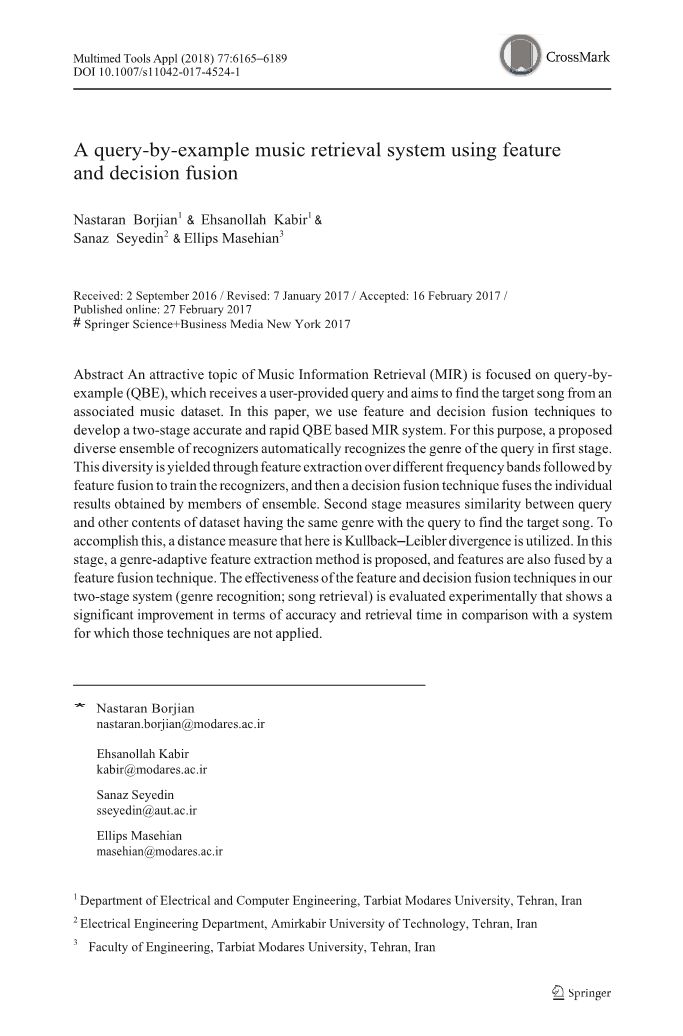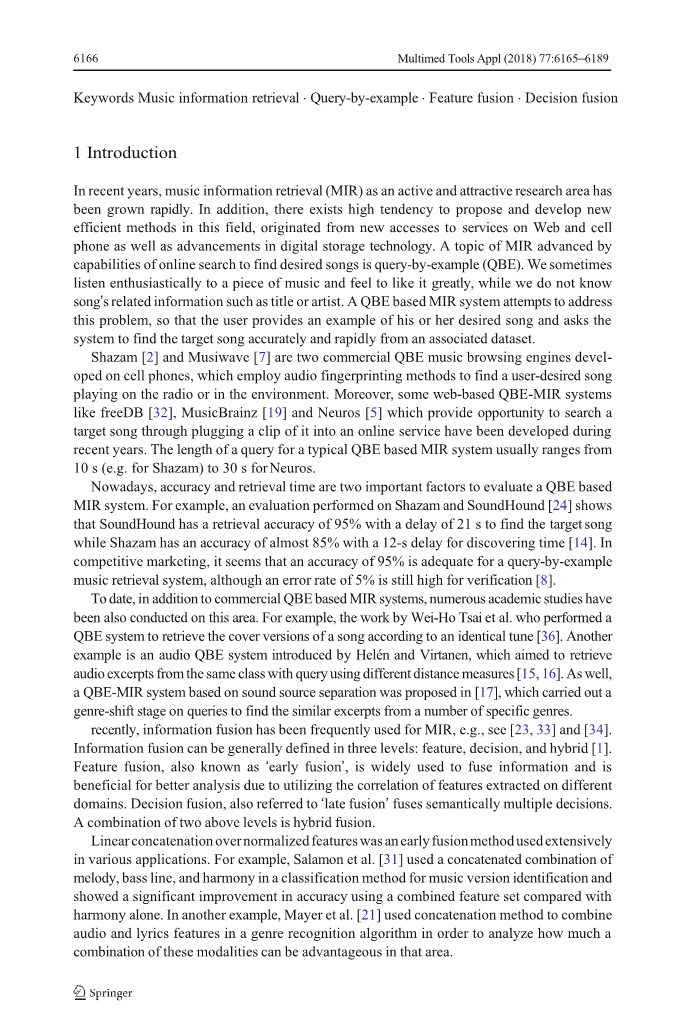

英语原文共 28 页,剩余内容已隐藏,支付完成后下载完整资料
基于Java爬虫的在线音乐平台
A query-by-example music retrieval system using feature and decision fusion
Nastaran Borjian1 amp; Ehsanollah Kabir1 amp;
Sanaz Seyedin2 amp; Ellips Masehian3
Received: 2 September 2016 / Revised: 7 January 2017 / Accepted: 16 February 2017 /
Published online: 27 February 2017
# Springer Science Business Media New York 2017
Abstract An attractive topic of Music Information Retrieval (MIR) is focused on query-by- example (QBE), which receives a user-provided query and aims to find the target song from an associated music dataset. In this paper, we use feature and decision fusion techniques to develop a two-stage accurate and rapid QBE based MIR system. For this purpose, a proposed diverse ensemble of recognizers automatically recognizes the genre of the query in first stage. This diversity is yielded through feature extraction over different frequency bands followed by feature fusion to train the recognizers, and then a decision fusion technique fuses the individual results obtained by members of ensemble. Second stage measures similarity between query and other contents of dataset having the same genre with the query to find the target song. To accomplish this, a distance measure that here is Kullback–Leibler divergence is utilized. In this stage, a genre-adaptive feature extraction method is proposed, and features are also fused by a feature fusion technique. The effectiveness of the feature and decision fusion techniques in our two-stage system (genre recognition; song retrieval) is evaluated experimentally that shows a significant improvement in terms of accuracy and retrieval time in comparison with a system for which those techniques are not applied.
* Nastaran Borjian nastaran.borjian@modares.ac.ir
Ehsanollah Kabir kabir@modares.ac.ir
Sanaz Seyedin sseyedin@aut.ac.ir
Ellips Masehian masehian@modares.ac.ir
1 Department of Electrical and Computer Engineering, Tarbiat Modares University, Tehran, Iran
2 Electrical Engineering Department, Amirkabir University of Technology, Tehran, Iran
3 Faculty of Engineering, Tarbiat Modares University, Tehran, Iran
Keywords Music information retrieval . Query-by-example . Feature fusion . Decision fusion
Introduction
In recent years, music information retrieval (MIR) as an active and attractive research area has been grown rapidly. In addition, there exists high tendency to propose and develop new efficient methods in this field, originated from new accesses to services on Web and cell phone as well as advancements in digital storage technology. A topic of MIR advanced by capabilities of online search to find desired songs is query-by-example (QBE). We sometimes listen enthusiastically to a piece of music and feel to like it greatly, while we do not know songrsquo;s related information such as title or artist. A QBE based MIR system attempts to address this problem, so that the user provides an example of his or her desired song and asks the system to find the target song accurately and rapidly from an associated dataset.
Shazam [2] and Musiwave [7] are two commercial QBE music browsing engines devel- oped on cell phones, which employ audio fingerprinting methods to find a user-desired song playing on the radio or in the environment. Moreover, some web-based QBE-MIR systems like freeDB [32], MusicBrainz [19] and Neuros [5] which provide opportunity to search a target song through plugging a clip of it into an online service have been developed during recent years. The length of a query for a typical QBE based MIR system usually ranges from 10 s (e.g. for Shazam) to 30 s for Neuros.
Nowadays, accuracy and retrieval time are two important factors to evaluate a QBE based MIR system. For example, an evaluation performed on Shazam and SoundHound [24] shows that SoundHound has a retrieval accuracy of 95% with a delay of 21 s to find the target song while Shazam has an accuracy of almost 85% with a 12-s delay for discovering time [14]. In competitive marketing, it seems that an accuracy of 95% is adequate for a query-by-example music retrieval system, although an error rate of 5% is still high for verification [8].
To date, in addition to commercial QBE based MIR systems, numerous academic studies have been also conducted on this area. For example, the work by Wei-Ho Tsai et al. who performed a QBE system to retrieve the cover versions of a song according to an identical tune [36]. Another example is an audio QBE system introduced by Heleacute;n and Virtanen, which aimed to retrieve audio excerpts from the same class with query using different distance measures [15, 16]. As well, a QBE-MIR system based on sound source separation was proposed in [17], which carried out a genre-shift stage on queries to find the similar excerpts from a number of specific genres.
recently, information fusion has been frequently used for MIR, e.g., see [23, 33] and [34]. Information fusion can be generally defined in three levels: feature, dec
剩余内容已隐藏,支付完成后下载完整资料
资料编号:[259361],资料为PDF文档或Word文档,PDF文档可免费转换为Word
以上是毕业论文外文翻译,课题毕业论文、任务书、文献综述、开题报告、程序设计、图纸设计等资料可联系客服协助查找。


